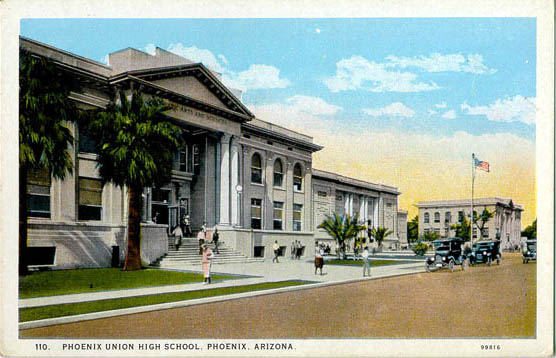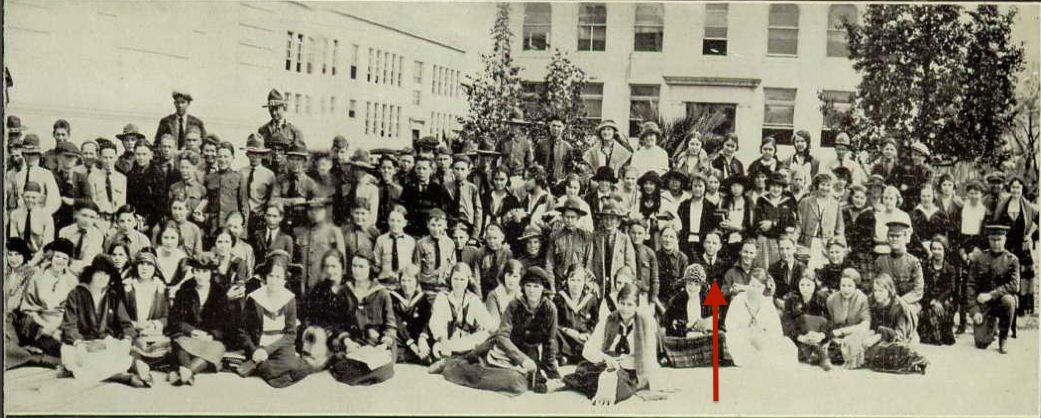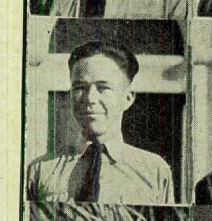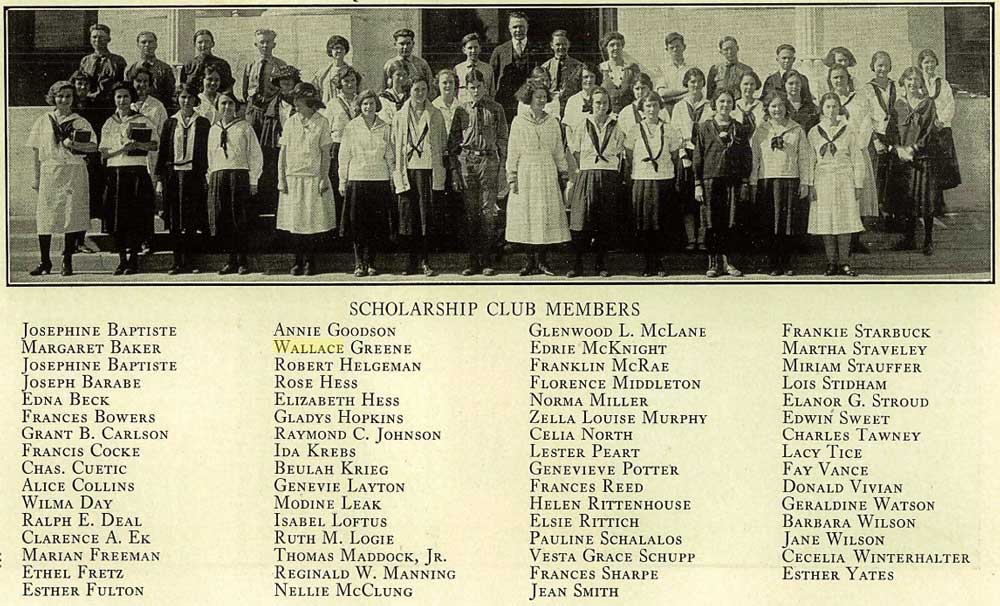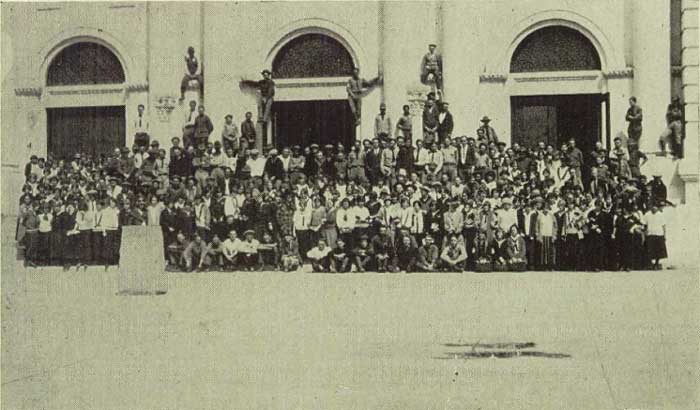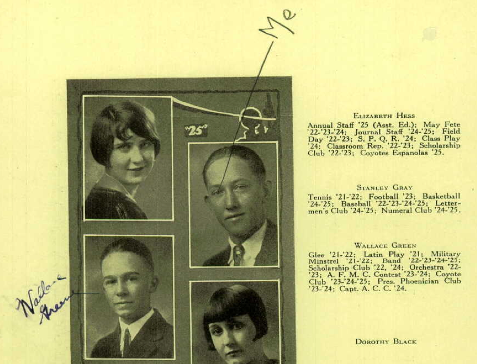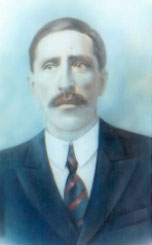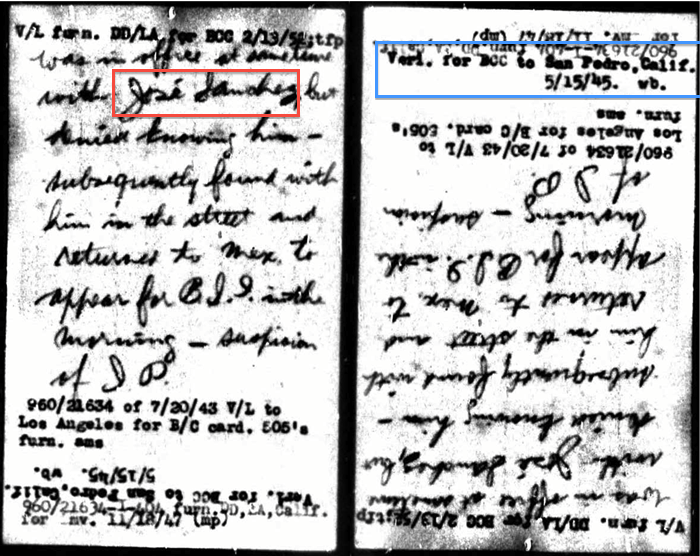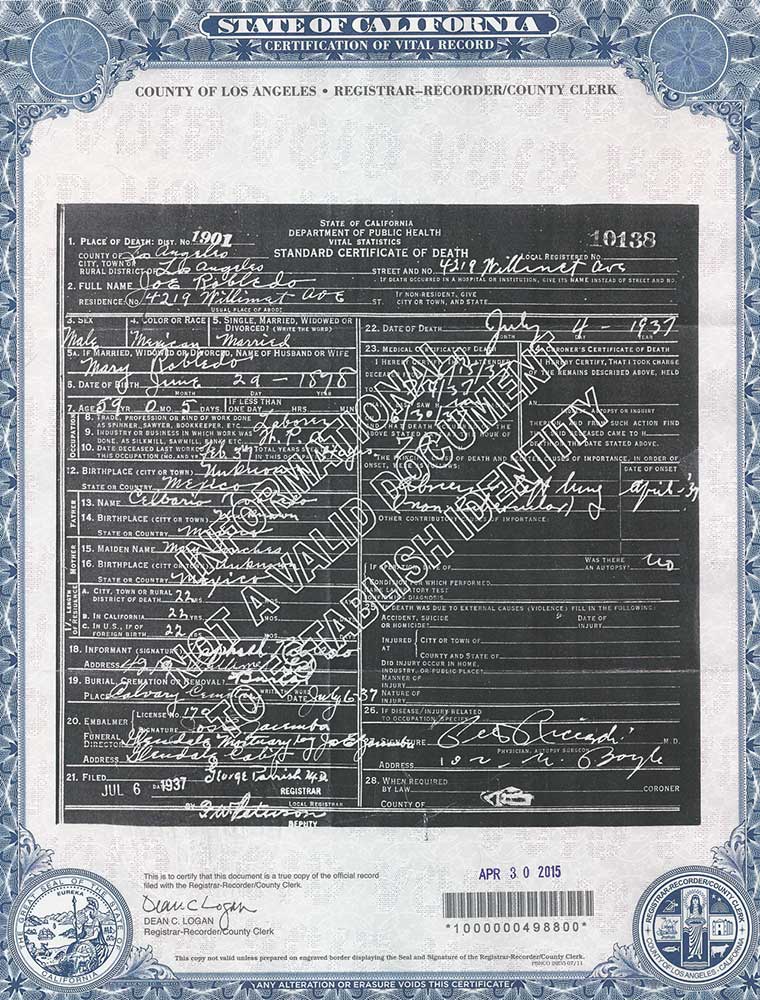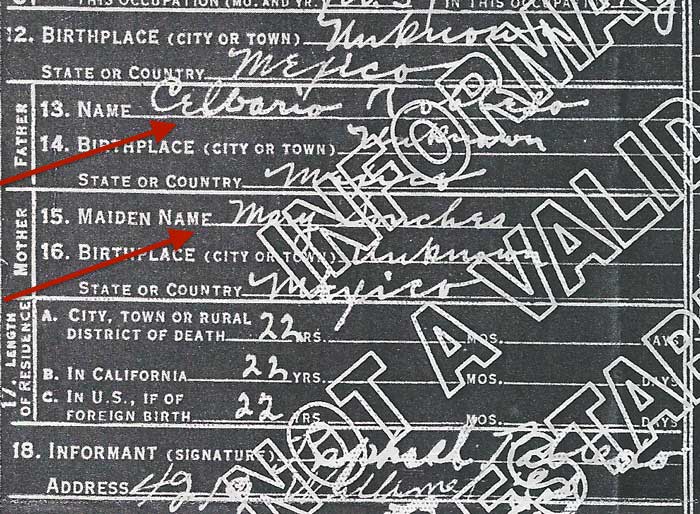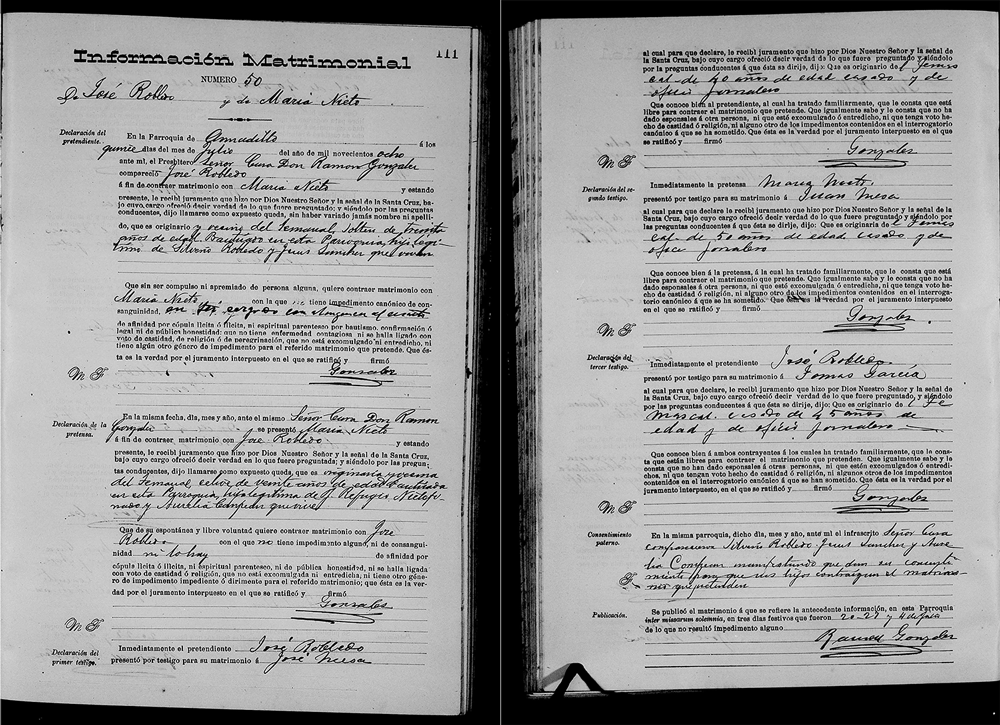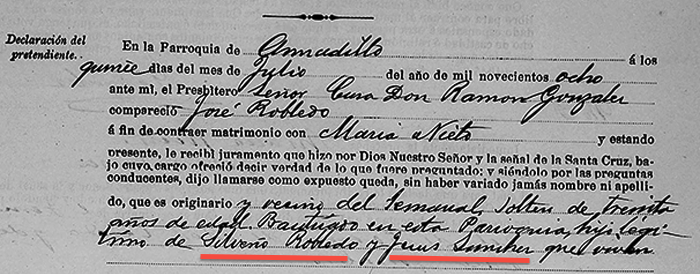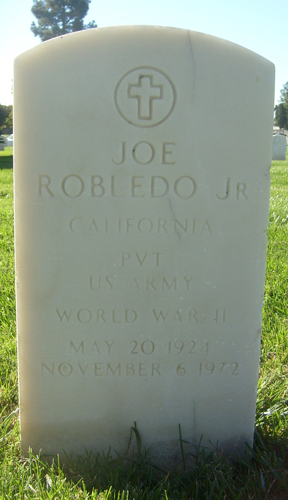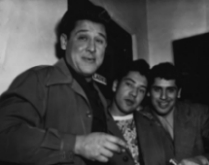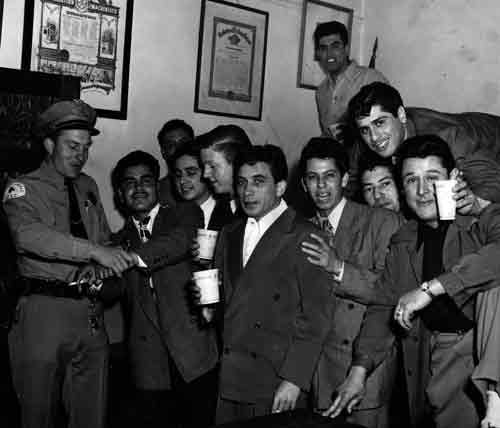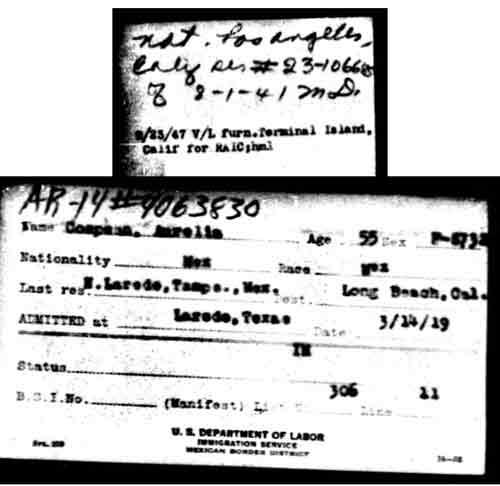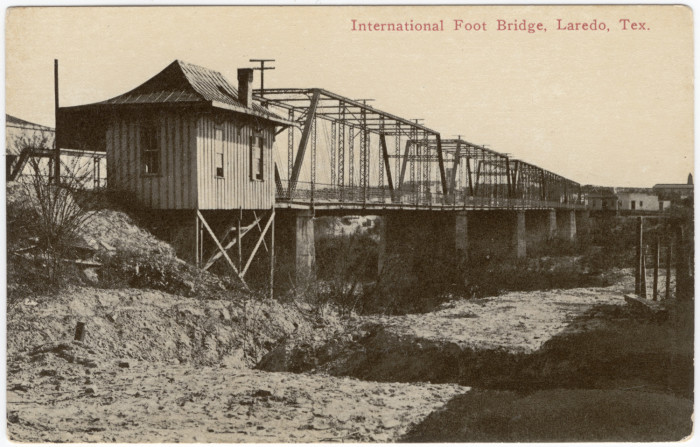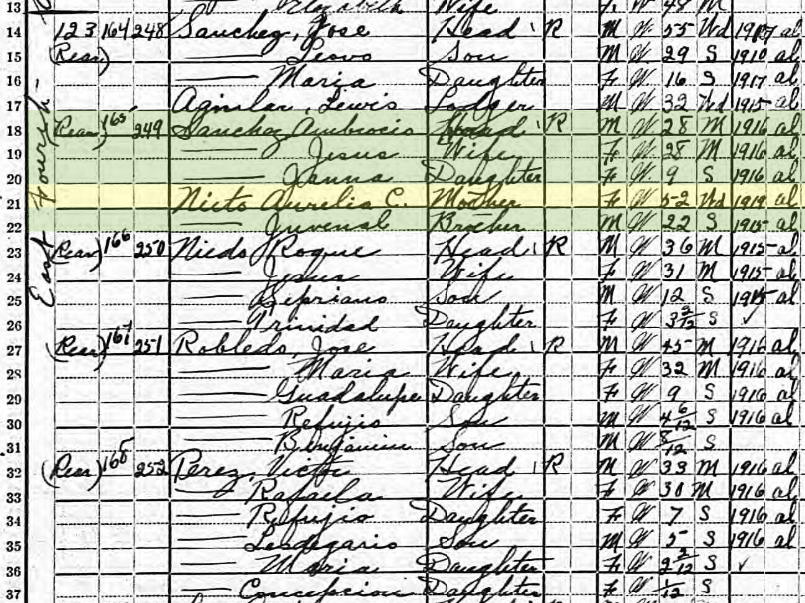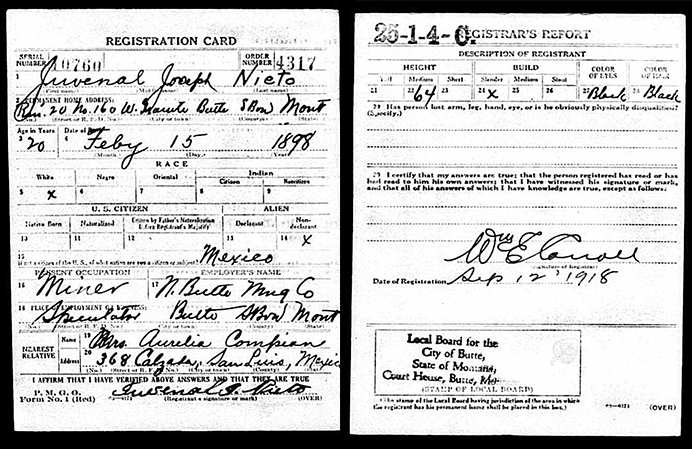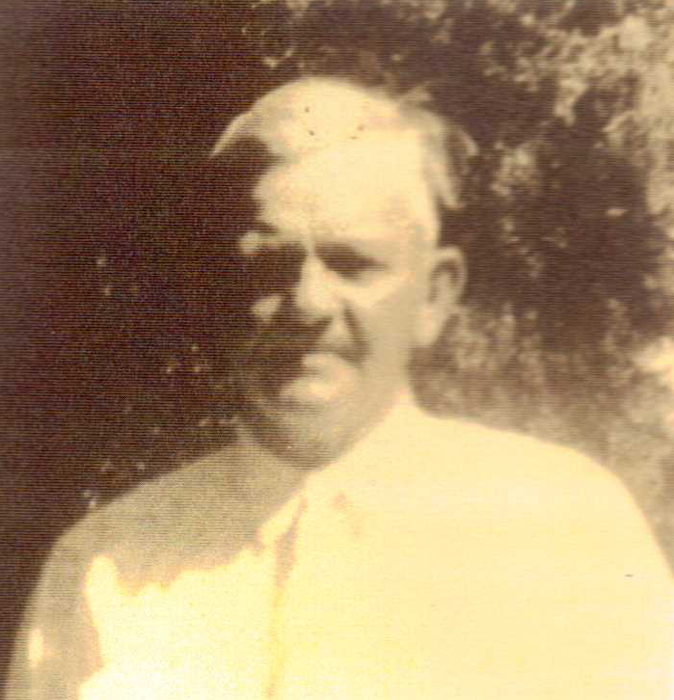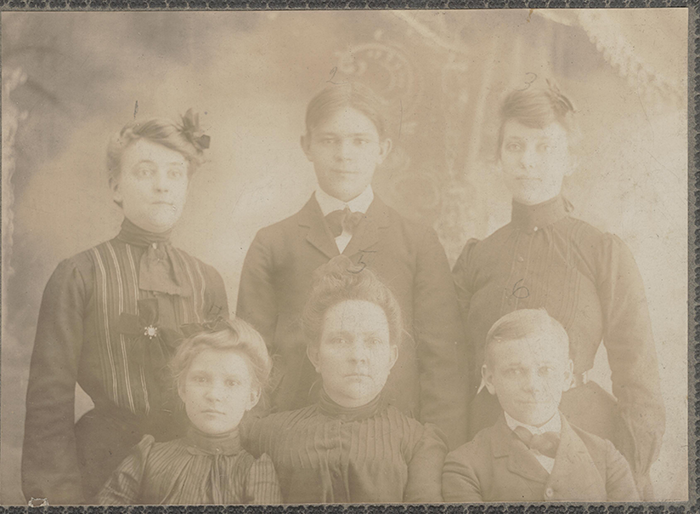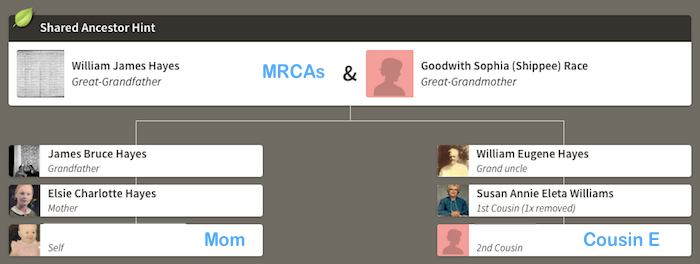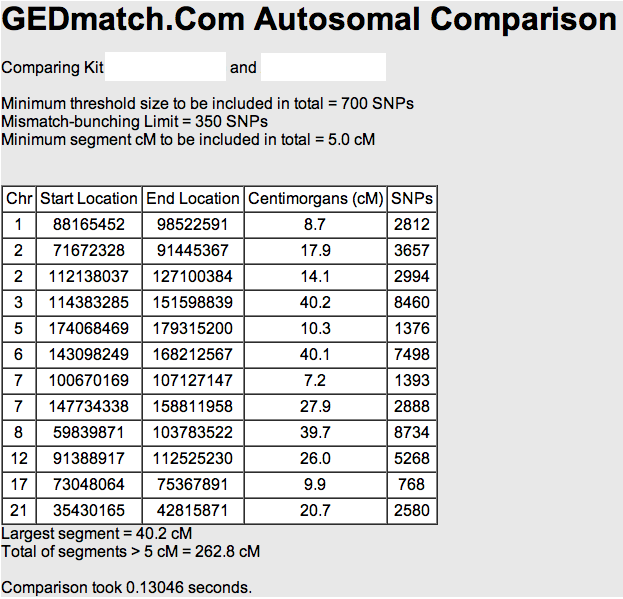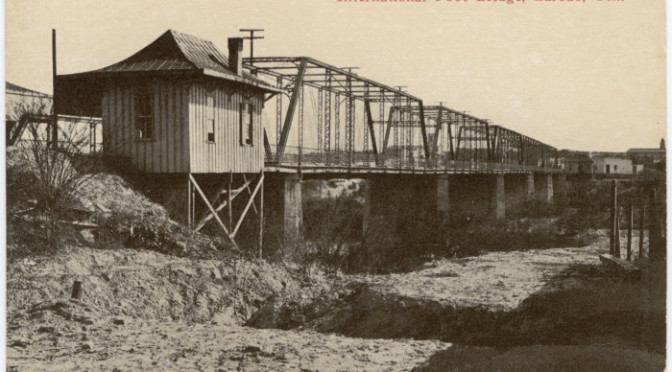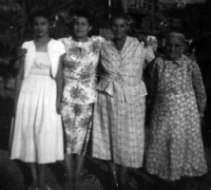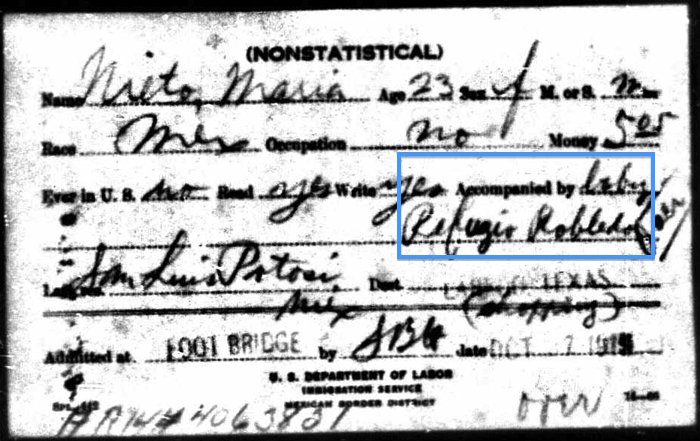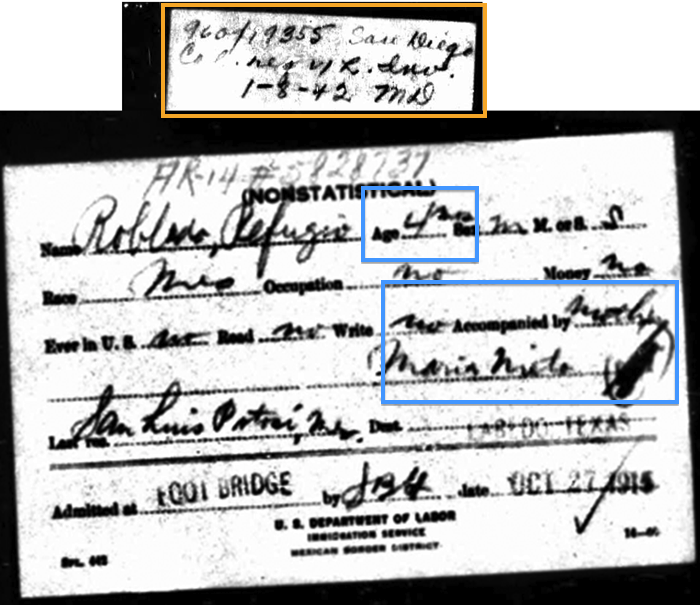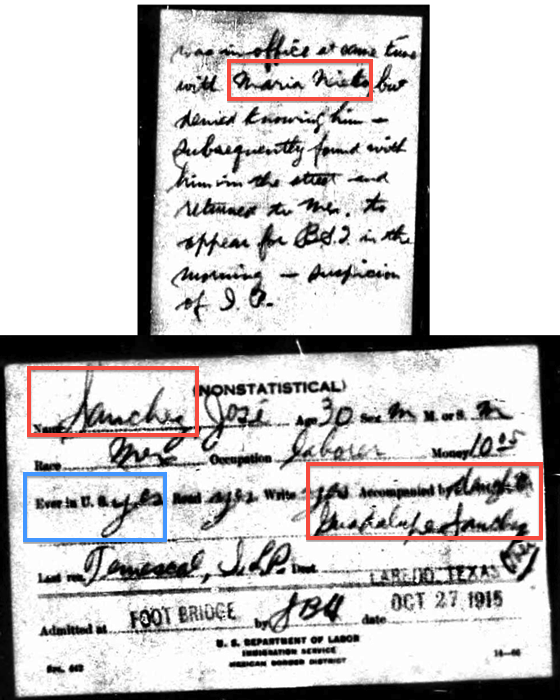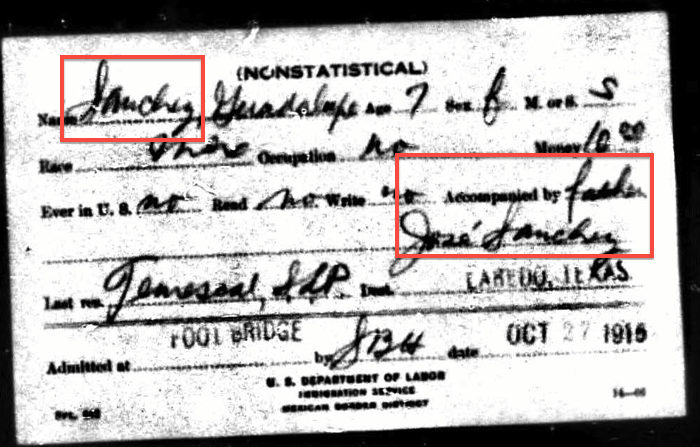My 23rd entry in Amy Johnson Crow’s “52 Ancestors in 52 Weeks” family history blogging challenge for 2015.
The challenge: have one blog post each week devoted to a specific ancestor. It could be a story, a biography, a photograph, an outline of a research problem — anything that focuses on one ancestor.
Amy’s 2015 version of this challenge focuses on a different theme each week.
The theme for week 23 is– Wedding: June is time for weddings. Write about a June bride in your family or highlight a favorite wedding photo. Maybe there’s a serial marry-er in the family — that could be a fun post!
I am quite behind on this blog challenge, hence the late wedding post.
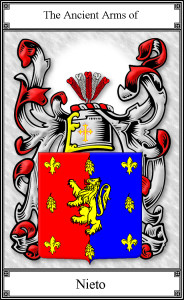 My 23rd ancestor is my 2nd great-grandfather Refugio Nieto (1863-1909), who was born about 1863 in the state of San Luis Potosí, Mexico. I have not yet identified the specific location, but it likely was in the municipality of Armadillo de los Infante.1
My 23rd ancestor is my 2nd great-grandfather Refugio Nieto (1863-1909), who was born about 1863 in the state of San Luis Potosí, Mexico. I have not yet identified the specific location, but it likely was in the municipality of Armadillo de los Infante.1
Marriage
Refugio married my 2nd great-grandmother Maria Aurelia Compean on 18 October 1883 in the parish of San José, located in Villa de Yturbidge (now Villa Hidalgo), a municipality in the state of San Luis Potosí.2
Aurelia (called “Little Grandma” by our family) immigrated to the U.S. in 1919 joining some of her children and great-grandchildren in Long Beach, Los Angeles County, California.3,4 Refugio died before the family immigrated.5,6 Consequently, my living family members never knew anything about him, including his given name.
The Original Record
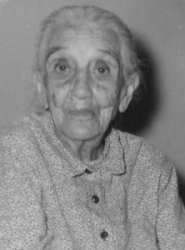
I wrote just a couple months ago about the recent discovery of this marriage record and of my 2nd great-grandfather’s given name of Refugio. Finding Refugio and Aurelia’s marriage record provided the first piece of (long-awaited) primary and direct evidence of their marriage as well as of my 2nd great-grandfather’s name. But I did not spend much time in that post analyzing the actual marriage record.
At that time, I was able to glean some key pieces of information from this Spanish language record (I do not speak Spanish, and my reading ability is very rudimentary). But to properly analyze the record for genealogical evidence, I needed to understand this record better.
That’s where my Spanish-fluent retired Dad comes in; I assigned a translation to him as homework last week. I think Dad enjoyed getting to read in-depth the marriage record for his great-grandparents and helping me piece together their history.
Pre-Marriage Investigations
The record referenced in this blog post is what the Spanish Catholic church refers to as a pre-marriage investigation report (called informaciones matrimoniales in the Mexican church). These investigations were conducted by the parish priest, prior to marrying a couple, to ensure that the couple met the church’s requirements for marriage.
The honor of the Catholic Church as an institution was maintained by being certain that a full investigation was conducted and the parties were free from (that is, they were not in violation of) the impediments imposed by Catholic canon law.7
Informacion Matrimonial
Below is the digitized copy of the marriage investigation record for my 3rd great-grandparents. Note that it spans two pages in the volume, and is rich with genealogical information.
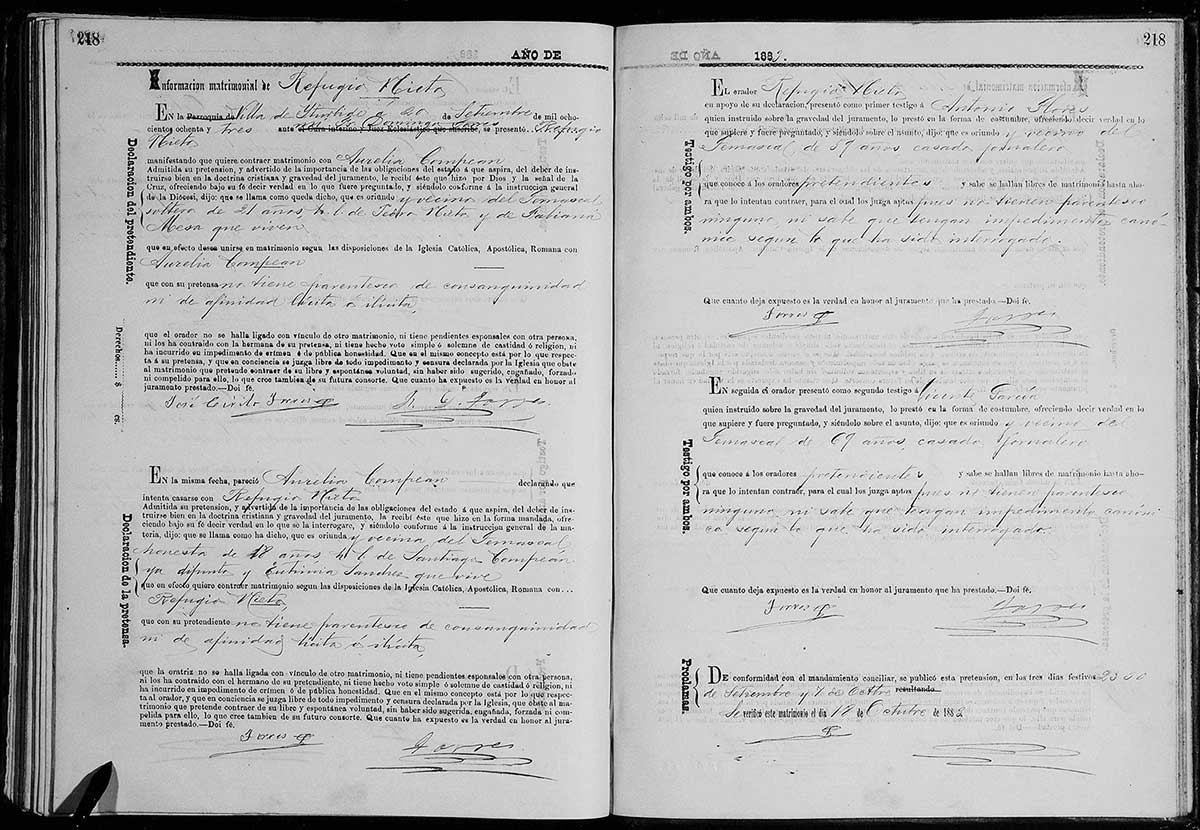
The Record Translation
Following is the verbatim translation provided by my father. Since Dad used parenthesis and brackets for his notes, I am enclosing mine {in braces}.8 In Dad’s own words, “The translation is a bit rough partially because the document is in old Spanish.” 9
For each part to the record, I have inserted the corresponding section from the digitized record above, to more easily refer to it while reading the translation.
{Introduction by the Priest & Statement by the Groom}
Marriage information {for Refugio Nieto}
Male spouse
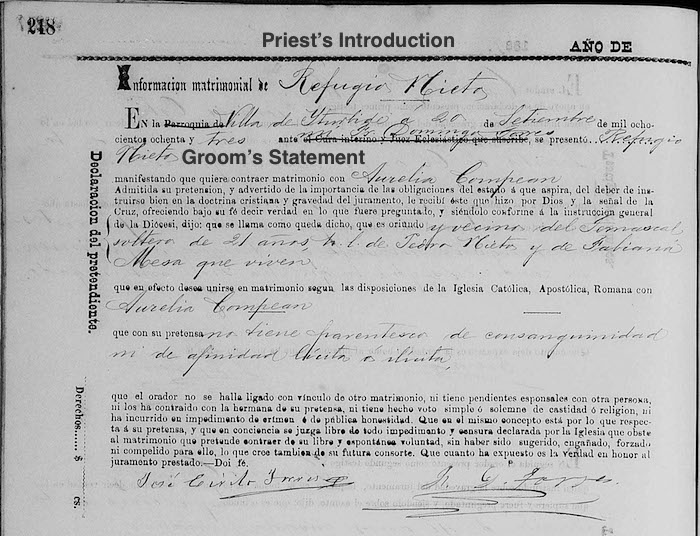
In the village of Ytarbido (?) {Yturbide} on 20 September, 1883, before me Father Domingo Torres, Refugio presented himself to reveal his desire to marry with Aurelia Compeon. Declaring his petition, and understanding the importance of the obligation of his desire, understanding well the Christian doctrine and the gravity of his affirmation, I received before God and the cross, by his faith he answered all the questions he was asked, agreeable to the general instructions of the diocese, that he is a resident of the district of Temascal {also Temazcal, a village in the muncipality of Armadillo de los Infante}, unmarried of 21 years of age, of Tedra {possibly Pedro} Nieto and of Fabriana {likely Fabiana} Mesa who are alive, who desires to wed Aurelia Compeon per the requirements of the Roman Apostolic Catholic Church, with his petition he affirms that he has no ties of consequence to another marriage, nor to another woman, nor to the sister of the proposed spouse, nor a vow of chastity, nor any liability of criminal or civil dishonesty. By this proposed marriage contract with respect for the spouse, being of clear conscience free of any burden I declare by the Church to enter marriage of my own free will without urging, force, or compelling, and I believe this to be true of my future spouse. All I have put forth is true and honest.
[The signatures may be from a church witness and Father Torres]
{Statement by the Bride}
Female spouse
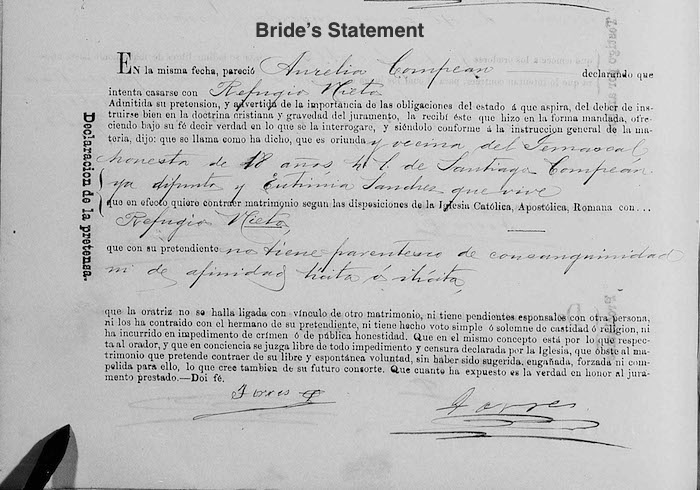
On the same date, Aurelia Compeon appeared to declare her intention to marry Refugio Nieto. Declaring her petition, and understanding the importance of the obligation of her desire, understanding well the Christian doctrine and the gravity of his affirmation, I received this statement as required, by her faith she answered all the questions she was asked, agreeable to the general instructions of the diocese, that she is a resident of the district of Temascal {same village as Refugio}, unmarried of 18 years of age, of Santiago Compeon now deceased and Eutimia Sanches who is alive, who desires to wed Refugio Nieto per the requirements of the Roman Apostolic Catholic Church, with his petition he affirms that he has no ties of consequence to another marriage, nor to another man, nor to the brother of the proposed spouse, nor a vow of chastity, nor any liability of criminal or civil dishonesty. By this proposed marriage contract with respect for the spouse, being of clear conscience free of any burden I declare by the Church to enter marriage of my own free will without urging, force, or compelling, and I believe this to be true of my future spouse. All I have put forth is true and honest.
[The signatures may be from a church witness and Father Torres]
{Statement by the First Witness}
First witness
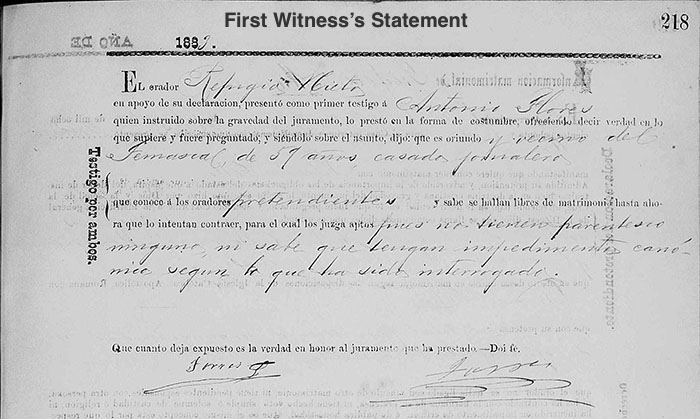
The petitioner Refugio Nieto in support of his declaration presented his first witness Antonio Flores who understood the importance of his oath, rightfully offered to speak the truth to answer all that was asked, and doing so for this matter, that he is a resident of the district of Temascal, 57 years of age married. He knows the petitioners to free of marriage and knows of no obstacles about what has been asked. All I have put forth is true and honest.
[The signatures may be from a church witness and Father Torres]
{Statement by the Second Witness}
Second witness
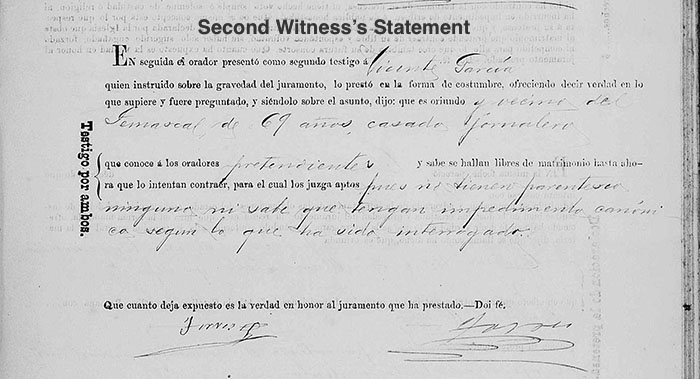
The petitioner Refugio Nieto in support of his declaration presented his second witness Vicente Garcia who understood the importance of his oath, rightfully offered to speak the truth to answer all that was asked, and doing so for this matter, that he is a resident of the district of Temascal, 69 years of age married. He knows the petitioners to free of marriage and knows of no obstacles about what has been asked. All I have put forth is true and honest.
[The signatures may be from a church witness and Father Torres]
{Certification by the Priest}

Consent with the required waiting, this petition is made public from September 23 to October 7, 1883.
This marriage was verified October 18, 1883.
Evidence Analysis
What sort of new information items did this record present to me to analyze as evidence?
My rudimentary Spanish reading ability at the time of discovery allowed me to:
- Identify their date and place of marriage.
- Identify the given name for my Nieto 2nd great-grandfather Refugio.
- Identify the names of Refugio Nieto’s parents (my 3rd gg).
- Confirm the names of Maria Aurelia Compean’s parents (my other 3rd gg).
What new information did I learn from Dad’s translation?
- That 3rd great-grandfather Jose Compean was already dead by this time. This helps me narrow the scope a bit in searching for a church death record for Jose.
- Because the parish is located in Villa de Yturbide, I assumed that was also the home town of Refugio when I attempted to read the original document, but Dad’s translation indicates both parties lived in the village of Temascal. Since Temascal lies in the municipality of nearby Armadillo de los Infante and is served by the parish of San Isabél (established 1610), I have a bit of research to do to determine why my 3rd great-grandparents married outside of their home parish.
[contentblock id=45 img=html.png]
